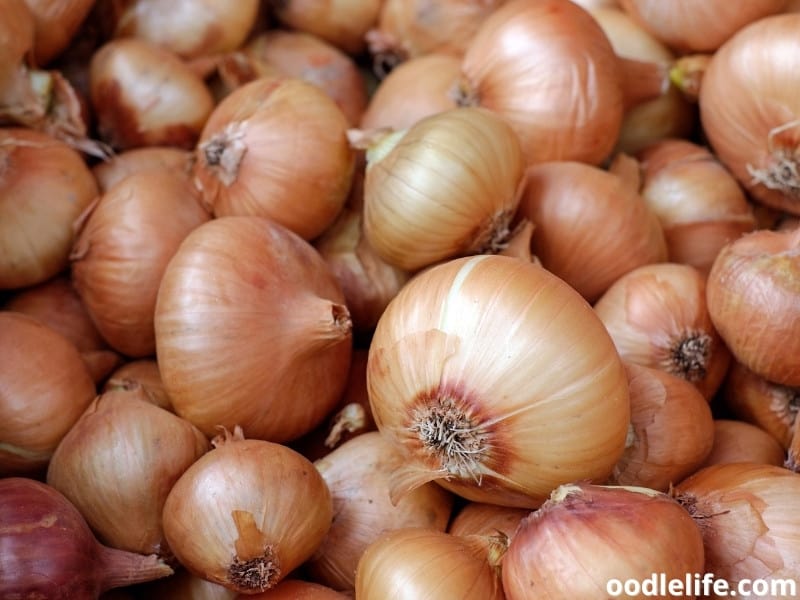Symptoms of Onion Toxicity in Dogs
Symptoms you should look out for include:
Onion toxicity is not a common cause of the last three symptoms but could be the culprit if you know or suspect your dog has gotten into some onions recently.
Onion ingestion in dogs can also lead to:
Many of the signs and symptoms listed above are actually caused by Heinz Body Anemia, or Hemolytic anemia. This is a condition that is brought on by the destruction of the dog’s red blood cells, which leads to a decrease in his red blood cell count, causing anemia.
The symptoms a dog experiences will depend on the number of onions it has consumed, its size, and the time period in which the onions were ingested. Consuming a large quantity of onions in a single sitting is actually less dangerous than eating a small number over a long period of time. This is important to remember if you are someone who likes to feed your dog from the table, as many foods people eat contain at least a small number of onion powder in them. Make sure you read your food labels carefully so you aren’t unintentionally poisoning your dog.
It’s also important to note that symptoms typically won’t appear for a few days after the dog has consumed the onions, and it may be safe to monitor your pet, however, if a large number of onions are mysteriously missing, you should bring your dog in to see your veterinarian just in case.
Likewise, if you know for sure that your dog has consumed a large amount of onions, it’s best to take your dog to your veterinarian immediately. Your vet will diagnose your dog’s condition based on his symptoms and blood work and may induce vomiting or give your dog a solution that will help decrease the absorption of the onions in the blood. Getting your dog into the vet quickly may help spare you some costly medical bills that are associated with overnight stays and monitoring should your dog’s onion toxicity reach dangerous levels.
It’s certainly easiest for your veterinarian to make a diagnosis if you know that your dog has ingested onions or a product that contains onions. If your dog is already showcasing symptoms like lethargy and weakness, then a low red blood cell count will likely be visible on a blood test. This can help indicate how severe the problem is as well.
Hemoglobin forms clumps on your dog’s red blood cells, which makes them not carry oxygen as well. When your veterinarian views your dog’s blood sample under a microscope, a dog with onion toxicity will showcase the telltale sign of these little clumps, which appear purple on the red blood cells. Other health conditions can cause these symptoms, but if it is suspected that the dog consumed onions, this will often be enough for a diagnosis.
Other times, your veterinarian will also conduct a urinalysis to see if there are high levels of hemoglobin in the urine. Heinz body anemia may also be visible in a blood smear examination even before the condition has caused a drop in the dog’s red blood cell count.
Other times, you may have to check your dog’s stool for undigested pieces of onion or analyze his vomit if he has become nauseous. Your veterinarian may also ask you what foods you regularly give your dog, and have you check the labels for a list of ingredients.
What Part of an Onion is Toxic to Dogs?
No specific part of an onion carries the toxin that is harmful to dogs — they’re in the whole thing! Onion Toxicosis can occur from ingestion of:
This means that onions can cause harm to dogs if they are consumed even after they are cooked, fried, or powdered.

Onion powder is also in a surprisingly wide range of human foods, and it doesn’t take a lot of onion to get a dog sick. For example, a 45-pound dog would only need to eat one medium raw onion to experience dangerous levels of toxicity. It’s difficult to keep a watchful eye on a dog at all times when food is out, but it is especially important if onions are involved.
Why Onions Are Toxic to Dogs?
The reason that onions are toxic to dogs is that they contain n-propyl disulfide.
I won’t get too scientific on you, but N-propyl disulfide breaks down red blood cells, which can result in anemia. Anemia is dangerous because it causes arrhythmia (irregular heartbeat) and an increased heart rate.
As a result, your dog’s heart has to work faster to pump blood throughout its body, leading to an enlarged heart, heart failure, and, in worst-case scenarios, death.
Although some people can experience allergic reactions or issues with drug interactions when consuming onions, onions generally don’t have the toxic effect on humans as they do on dogs.

Onions are part of the allium species, which is a group of plants that can create toxic reactions to dogs. So, aside from eating onion, your dog could have an increased chance of toxicity if the onion-filled dish also contained allium species such as:
Luckily, most dogs won’t naturally want to gobble up these foods. That’s why toxicity from onion and other allium species more commonly occurs from them eating a dish containing one or more of these ingredients.
If it’s any consolation, garlic is the most toxic of all the allium species; it’s about five times more toxic than onion.

Garlic and Onion toxicity in dogs. What to expect and do if your dog eats garlic or onions
Onions are unique members of the root vegetable family because they (like garlic) are bulbs and do not grow as deeply as other root vegetables. Onions come in white, yellow, and red bulbs, as well as chives and leeks, and are a common flavorful addition to meals and side dishes, served both cooked and raw. They help bring flavor to many of our favorite dishes, but can dogs eat onions? If your dog ate onions, what do you do?